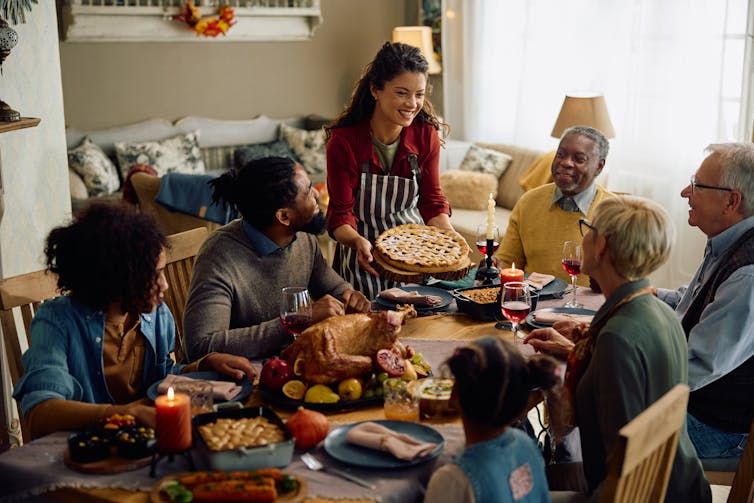
Catherine Falls Commercial/Moment via Getty Images
Alexandra Plakias, Hamilton College
The holidays offer many opportunities for awkward moments. Political discussions, of course, hold plenty of potential. But any time opinions differ, where estrangements have caused lingering rifts, or when behaviors veer toward the inappropriate, awkwardness can set in.
Awkwardness is what happens in social interactions when you suddenly find yourself without a script to guide you through. Maybe the situation is new or catches you off guard. Maybe you don’t know what’s expected of you, or you aren’t sure what role you’re playing in the social drama around you. It’s characterized by feelings of self-consciousness, uncertainty and discomfort.
As a philosopher who studies moral psychology, I’m interested in awkwardness because I wanted to understand the ways social discomfort stops people from engaging with difficult topics and challenging conversations. Awkwardness seems to inhibit people, even when their moral values suggest they should speak up. But it has a positive role to play, too – it can alert people to areas where their social norms are lacking or outdated.
People often blame themselves when things take a turn toward the awkward. But awkwardness is really a collective failure – people aren’t awkward, situations are. And they become awkward because you don’t have the resources to navigate your way through tricky social situations.
Awkwardness is often confused with embarrassment, but the two are different in important ways, and so are their remedies. Embarrassment is a response to a personal failing or gaffe, and the right response is to acknowledge it, own it and move on. Because awkwardness is caused by a lack of social guidance, you can try to anticipate and head it off before it happens, or you can respond to it by trying to develop better or clearer social scripts to help you – and others – navigate similar situations in the future.
After researching and writing an entire book on awkwardness, I’ve come to the conclusion that it’s not something we can – or should – avoid altogether. But there are a few strategies people can use to minimize awkwardness and deal with it when it does, inevitably, happen.
1. Know your goals, know your roles
Uncertainty is the oxygen of awkwardness. Before you engage in a potentially awkward or contentious interaction, ask yourself: What do I want to get out of this?
When you’re clear on your goals for the interaction, not only are you better able to perform your role in it, but you’re also giving clearer signals to others, helping them perform their roles in the unfolding social drama.
So, if you’re worried it’ll be awkward when your uncle starts in on his annual political rant, think about what you want the outcome to be. Do you want to convince him he’s wrong? Unlikely to happen. Do you want other family members to feel less anxious? Do you want your own views to be heard?
I’m not suggesting that some forethought will make things go smoothly or guarantee that no one’s feelings will be hurt. But it will help you feel more confident in your ability to navigate toward your desired outcome.

Drazen Zigic/iStock via Getty Images Plus
2. There’s no ‘I’ in awkward
Awkward situations breed intense self-consciousness. This is both uncomfortable and counterproductive. By focusing on yourself, you’re not attuned to the people around you or the signals they’re sending – signals that could offer you a pathway out of the awkward situation. So make sure you’re paying attention to the other players in the drama, not just your own discomfort.
3. Plan, coordinate and be explicit
People do so much planning in other areas of their lives, yet they expect social interactions to just flow effortlessly. But like a vacation or a hike in the woods, sometimes a conversation goes better when you approach it with a map. Have some go-to topics or questions at hand.
And you don’t have to go it alone. If you’re worried about broaching a sensitive topic, or interacting with a particularly prickly guest, coordinate with a friend or relative.
If you expect to see someone with whom you have an unresolved relationship – an estranged family member, an old friend you ghosted – try to do some prep work in advance. Emails or letters can give people a chance to process reactions without putting them on the spot.
Even having a scripted activity on deck can make things less awkward. It doesn’t have to be anything formal, like a board game. Just keep some tasks available for guests who might otherwise lurk uncomfortably – like shaking up the salad dressing or putting forks on the table.
4. Laugh it off
If, despite your best efforts, awkwardness does strike, offer people a way out – they’ll probably grab it. This doesn’t need to be momentous; it could be a little joke, a small-talk topic, or even – and only if things get very desperate – knocking a spoon off the table to break the silence.
5. Consider the alternatives
These strategies might help you avoid awkwardness. But take a moment to consider whether you really want to. Awkwardness is the result of social uncertainty; it slows things down and curbs your confidence.
In its absence, other emotions can set in. Having things out in the open can be a relief, but it can also lead to anger, sadness and other feelings that might best be saved for another occasion.
So if things are awkward, it’s worth looking around to see what role that awkwardness is playing, and what might take its place if it’s gone.![]()
Alexandra Plakias, Associate Professor of Philosophy, Hamilton College
This article is republished from The Conversation under a Creative Commons license. Read the original article.

























































